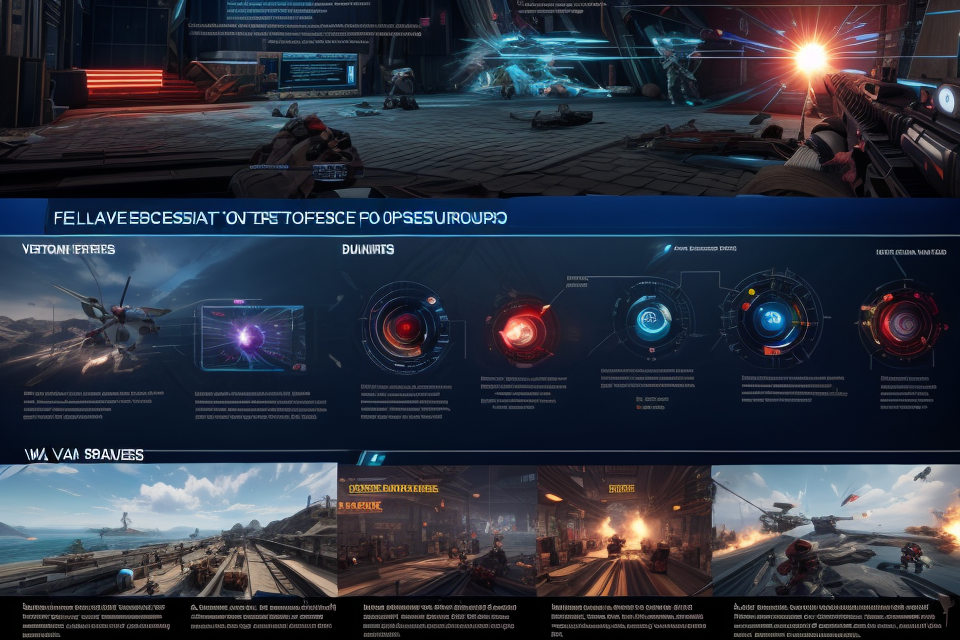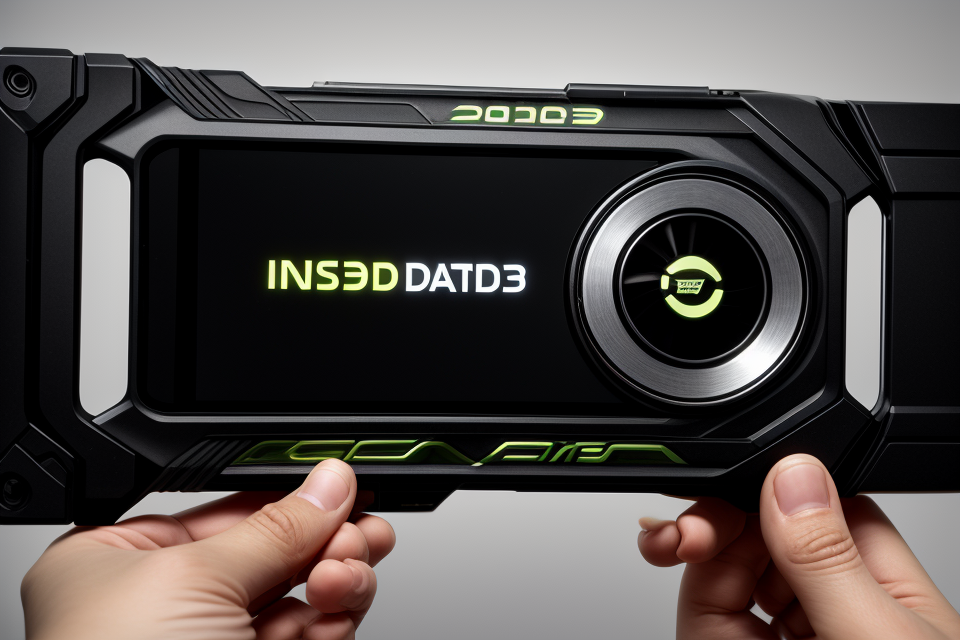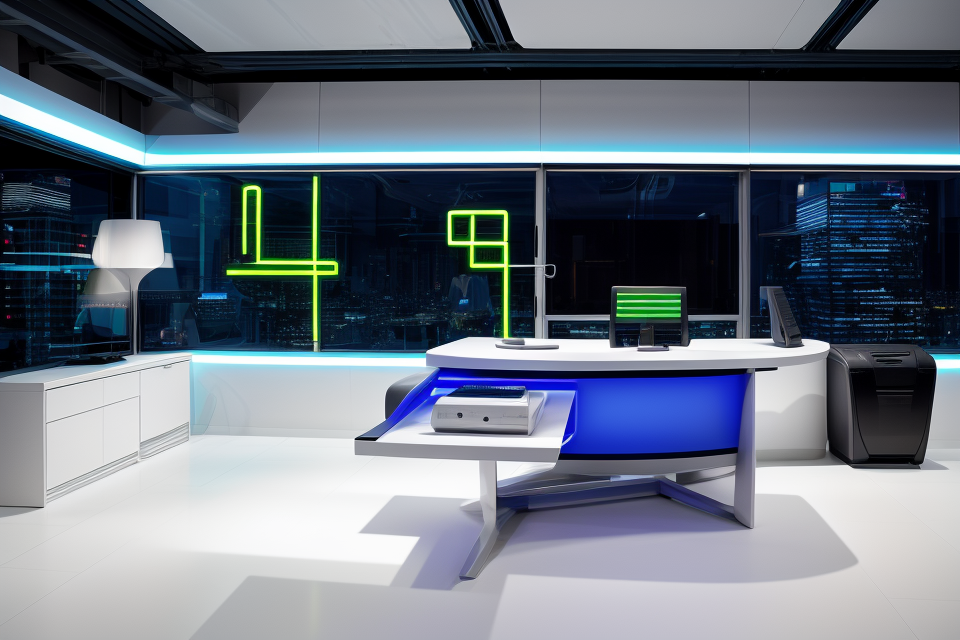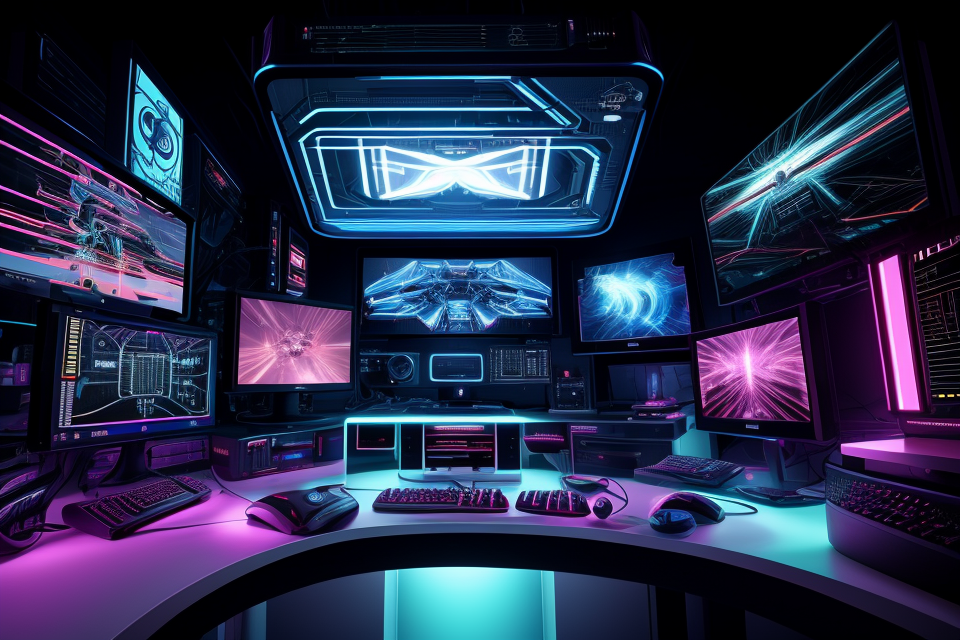
The world of gaming is constantly evolving, and with the introduction of cutting-edge technologies like DLSS and ray tracing, gamers are able to experience their favorite games in a whole new light. But, there is a common misconception that DLSS only works with ray tracing. In this article, we will delve into the relationship between DLSS and ray tracing, and separate fact from fiction. Whether you’re a seasoned gamer or just starting out, this article will provide you with a comprehensive understanding of these technologies and how they work together, or don’t. So, let’s get started and discover the truth behind the mysterious relationship between DLSS and ray tracing.
Understanding DLSS and Ray Tracing: Fundamentals and Basics
What is DLSS?
- A brief history of DLSS
DLSS, or Deep Learning Super Sampling, is a technology that utilizes artificial intelligence to enhance the performance of graphics cards in gaming and other graphically intensive applications. It was first introduced by NVIDIA in 2019 as a way to improve the image quality of games while reducing the workload on GPUs. - How DLSS works
DLSS works by using a neural network to upscale lower resolution images to higher resolutions. The neural network is trained on a large dataset of images and can identify and enhance details in the original image that would be lost during traditional upscaling methods. This results in higher image quality while using less computational power. - Advantages of using DLSS
One of the main advantages of using DLSS is that it can significantly improve the performance of graphics cards, particularly in games with high resolutions and frame rates. This can result in smoother gameplay and reduced input lag, leading to a better overall gaming experience. Additionally, DLSS can help reduce the heat output and power consumption of graphics cards, making them more energy efficient.
What is Ray Tracing?
- A brief history of Ray Tracing
Ray tracing is a technique that has been around for decades, first introduced in the 1960s by physicist L.G. Durand. The idea behind ray tracing is to simulate the behavior of light in a scene, tracing the path of each ray as it bounces off objects and interacts with the environment. - How Ray Tracing works
Ray tracing works by generating a large number of rays that originate from the virtual camera and pass through the scene. These rays are then analyzed at various points to determine their color and texture. The process involves many iterations, with each iteration refining the color and texture of the image until it reaches a desired level of accuracy. - Advantages of using Ray Tracing
Ray tracing offers several advantages over traditional rendering techniques. It produces more realistic lighting and shadows, resulting in more accurate reflections and refractions. It also allows for greater control over the visual appearance of an image, enabling artists and designers to create more visually appealing scenes. Additionally, ray tracing can be used to simulate a wide range of effects, including volumetric lighting, subsurface scattering, and global illumination.
The Connection Between DLSS and Ray Tracing
Do DLSS and Ray Tracing Work Together?
The role of DLSS in enhancing Ray Tracing performance
DLSS, or Deep Learning Super Sampling, is a technique that uses artificial intelligence to upscale lower resolution images to higher resolutions. It works by training a neural network to predict which pixels should be displayed at higher resolution, and then using this information to interpolate the missing data.
When used in conjunction with Ray Tracing, DLSS can significantly improve the performance of graphics cards. This is because Ray Tracing is a computationally intensive process that requires a lot of processing power to generate realistic lighting and shadows. By offloading some of the work to the neural network in DLSS, the graphics card can focus on other tasks, resulting in a smoother and more efficient overall experience.
How Ray Tracing enhances the visual experience with DLSS
Ray Tracing is a technique that simulates the behavior of light in a scene, resulting in more realistic reflections, refractions, and shadows. When used in conjunction with DLSS, this can result in a more visually stunning experience.
One of the key benefits of using DLSS with Ray Tracing is that it allows for more detailed and complex lighting effects. This is because the neural network in DLSS can generate higher resolution images with more accurate color and lighting information. This information can then be used by the Ray Tracing algorithm to create more realistic reflections, refractions, and shadows.
Overall, the combination of DLSS and Ray Tracing can result in a more visually stunning and efficient gaming experience. By offloading some of the work to the neural network in DLSS, the graphics card can focus on other tasks, resulting in a smoother and more efficient overall experience. And by using more detailed and complex lighting effects, Ray Tracing can enhance the visual experience even further.
Can DLSS Be Used Without Ray Tracing?
DLSS, or Deep Learning Super Sampling, is a powerful technology that has revolutionized the gaming industry by providing higher frame rates and smoother graphics without compromising on image quality. However, it is important to understand the relationship between DLSS and Ray Tracing, which is another advanced graphics technology that enhances the realism and immersion of a game.
In simple terms, Ray Tracing is a technique that simulates the behavior of light in a virtual environment, providing more accurate reflections, shadows, and other lighting effects. DLSS, on the other hand, uses machine learning algorithms to optimize the performance of a game by rendering images at a lower resolution and then upscaling them to a higher resolution.
While both technologies work together to provide better graphics and performance, the question remains: can DLSS be used without Ray Tracing?
- Understanding the compatibility of DLSS with different graphics APIs
DLSS is compatible with different graphics APIs, including DirectX and Vulkan. However, it is important to note that DLSS requires a GPU that supports Tensor Cores, which are specialized processing units designed to accelerate machine learning workloads. Therefore, not all GPUs are compatible with DLSS, which limits its use without Ray Tracing.
- Exploring the limitations of using DLSS without Ray Tracing
Using DLSS without Ray Tracing can result in reduced image quality and less realistic lighting effects. While DLSS can improve frame rates and smoothen graphics, it cannot compensate for the lack of realism provided by Ray Tracing. In fact, some games may not even support DLSS without Ray Tracing, as the two technologies are designed to work together to provide the best possible gaming experience.
In conclusion, while DLSS can be used without Ray Tracing, it is not recommended as it will not provide the same level of image quality and realism. To get the most out of these advanced graphics technologies, it is important to use them together for the best possible gaming experience.
DLSS vs Ray Tracing: Performance and Visual Quality Comparisons
Performance Comparison
Examining the Impact of DLSS and Ray Tracing on Frame Rates and GPU Utilization
One of the primary concerns for gamers and developers alike is the impact of graphics technologies like DLSS and ray tracing on performance. To evaluate this, it is essential to measure the impact of these technologies on frame rates and GPU utilization.
Frame rates are a measure of the number of frames rendered per second, while GPU utilization measures the percentage of the GPU’s capacity being used. Higher frame rates generally indicate smoother gameplay, while higher GPU utilization may indicate a more demanding workload for the GPU.
Understanding the Trade-Offs Between Performance and Visual Quality
When evaluating the performance of DLSS and ray tracing, it is crucial to understand the trade-offs between performance and visual quality. While both technologies can enhance visual quality, they may also come with a performance cost.
For example, enabling ray tracing may result in lower frame rates, while using DLSS may result in some loss of visual quality. It is essential to balance the visual quality desired with the performance required for smooth gameplay.
To evaluate the trade-offs between performance and visual quality, it is helpful to measure the performance impact of each technology individually and in combination. This allows developers and gamers to make informed decisions about which graphics technologies to use and how to optimize performance.
In summary, examining the impact of DLSS and ray tracing on frame rates and GPU utilization is critical to understanding their performance implications. It is also essential to understand the trade-offs between performance and visual quality when using these technologies. By measuring the performance impact of each technology individually and in combination, developers and gamers can make informed decisions about optimizing performance and achieving the desired visual quality.
Visual Quality Comparison
Analyzing the Differences in Image Quality between DLSS and Ray Tracing
One of the primary concerns for gamers and developers alike is the visual quality of a game. To analyze the differences in image quality between DLSS and Ray Tracing, we must first understand the underlying technology behind each technique.
DLSS utilizes machine learning to optimize the resolution of a game by upscaling or downscaling the resolution of the game’s image. This is done by training a neural network on a dataset of images, allowing the network to learn the relationships between different resolutions of the same image. During gameplay, the network uses this learned information to scale the resolution of the game’s image in real-time, providing a higher frame rate without sacrificing visual quality.
Ray Tracing, on the other hand, simulates the behavior of light in a scene, providing more realistic reflections, refractions, and shadows. This technique calculates the path of each ray of light as it interacts with objects in the scene, providing a more accurate representation of how light behaves in the real world. By simulating the behavior of light, Ray Tracing provides a more realistic and visually appealing image compared to traditional rasterization techniques.
Understanding the Role of Settings and Resolutions in the Visual Quality of DLSS and Ray Tracing
Another factor to consider when comparing the visual quality of DLSS and Ray Tracing is the role of settings and resolutions. Different games may have different settings that can affect the visual quality of the game, such as texture quality, shadow quality, and anti-aliasing. Additionally, the resolution of the game can also affect the visual quality, with higher resolutions providing more detailed images.
When comparing the visual quality of DLSS and Ray Tracing, it is important to consider the settings and resolution of the game being played. For example, if a game has lower settings and a lower resolution, the visual quality may not be as apparent when comparing DLSS and Ray Tracing. However, if a game has higher settings and a higher resolution, the visual quality differences between DLSS and Ray Tracing may be more apparent.
In conclusion, when comparing the visual quality of DLSS and Ray Tracing, it is important to consider the underlying technology behind each technique, as well as the role of settings and resolutions. While both techniques have their own advantages and disadvantages, understanding these factors can help provide a more accurate comparison of the visual quality of DLSS and Ray Tracing.
Debunking Common Myths and Misconceptions About DLSS and Ray Tracing
Myth: DLSS Requires Ray Tracing
- Examining the Relationship Between DLSS and Ray Tracing
Deep Learning Super Sampling (DLSS) and Ray Tracing are two of the most exciting technologies in the world of computer graphics. While both of these technologies are often used together, there is a common misconception that DLSS requires Ray Tracing. In this section, we will examine the relationship between DLSS and Ray Tracing and debunk the myth that DLSS requires Ray Tracing.
Understanding the Misconceptions Surrounding DLSS and Ray Tracing
The misconception that DLSS requires Ray Tracing likely stems from the fact that both technologies are often used together in modern graphics cards. However, it is important to understand that DLSS and Ray Tracing are two separate technologies that can be used independently of one another.
DLSS is a technique that uses artificial intelligence to upscale lower resolution images to higher resolutions. This technology is designed to improve the performance of games and other graphics-intensive applications by reducing the workload on the GPU.
On the other hand, Ray Tracing is a technique that simulates the behavior of light in a scene. This technology is used to create more realistic lighting and shadows in games and other graphics-intensive applications.
While both DLSS and Ray Tracing can be used together to create more realistic graphics, it is important to understand that they are two separate technologies that can be used independently of one another. Therefore, the myth that DLSS requires Ray Tracing is simply not true.
In conclusion, while DLSS and Ray Tracing are often used together, they are two separate technologies that can be used independently of one another. It is important to understand the relationship between these technologies and debunk the myth that DLSS requires Ray Tracing.
Myth: Ray Tracing is Only Useful for Realistic Graphics
Exploring the versatility of Ray Tracing in various game genres and scenarios
Ray tracing is a powerful technique that can enhance the visual quality of games by simulating the behavior of light in a virtual environment. It is often associated with realistic graphics, but it can also be used in other genres and scenarios to create unique visual effects.
Debunking the myth that Ray Tracing is only useful for realistic graphics
Many gamers believe that ray tracing is only useful for creating realistic graphics, but this is not entirely true. While it is true that ray tracing can be used to create highly realistic graphics, it can also be used to create unique visual effects in other genres and scenarios.
For example, in a fast-paced action game, ray tracing can be used to create stunning visual effects such as realistic reflections, refractions, and shadows. These effects can enhance the immersion of the player and make the game more enjoyable to play.
Similarly, in a puzzle game, ray tracing can be used to create visual cues that help the player navigate the environment. For example, ray tracing can be used to create realistic shadows that indicate the position of objects in the environment, or to create colorful refractions that highlight important objects or areas.
In conclusion, while ray tracing is often associated with realistic graphics, it can also be used in other genres and scenarios to create unique visual effects that enhance the overall gaming experience. By debunking the myth that ray tracing is only useful for realistic graphics, gamers can explore the full potential of this powerful technique and enjoy the many benefits it has to offer.
Future Developments and Integration of DLSS and Ray Tracing
How Will DLSS and Ray Tracing Evolve in the Future?
Examining the Potential Advancements in DLSS and Ray Tracing Technology
- AI-Enhanced Rendering: The incorporation of AI into DLSS and ray tracing could lead to more efficient and accurate rendering processes. AI algorithms can analyze and optimize rendering pipelines, resulting in faster performance and higher image quality.
- Improved Dynamic TXAA: Dynamic TXAA (TAA) is a technique that uses temporal anti-aliasing to produce high-quality images. Future advancements may lead to more efficient and effective dynamic TXAA implementations, further enhancing image quality in real-time.
- Variance Reduction Techniques: The development of variance reduction techniques could improve the performance and accuracy of DLSS and ray tracing. These techniques aim to reduce the noise and errors present in rendering calculations, resulting in smoother and more realistic images.
Speculating on the Future of DLSS and Ray Tracing Integration
- Expanded Compatibility: As DLSS and ray tracing technologies continue to advance, it is likely that they will become compatible with a wider range of devices and platforms. This could lead to more widespread adoption and more diverse applications of these technologies.
- Hybrid Rendering Techniques: Future developments may explore hybrid rendering techniques that combine the strengths of DLSS and ray tracing. This could result in more efficient and higher-quality rendering processes, offering more realistic and visually appealing images.
- Increased Customization: The future of DLSS and ray tracing may involve increased customization options for users. This could allow developers and users to tailor the rendering process to their specific needs and preferences, further enhancing the visual experience.
The Impact of DLSS and Ray Tracing on Gaming and Graphics
- DLSS and Ray Tracing: The Future of Gaming and Graphics
- The increasing demand for realistic graphics in gaming
- The growing popularity of real-time ray tracing in video games
- The potential for DLSS and ray tracing to revolutionize the gaming industry
- DLSS and Ray Tracing: Advancements and Innovations
- The integration of AI and machine learning in DLSS and ray tracing
- The development of more advanced and efficient algorithms for DLSS and ray tracing
- The potential for new and innovative applications of DLSS and ray tracing in gaming and graphics
- DLSS and Ray Tracing: The Future of Graphics and Gaming
- The impact of DLSS and ray tracing on the development of new graphics technologies
- The potential for DLSS and ray tracing to drive innovation in the gaming industry
- The future of graphics and gaming: A world where DLSS and ray tracing are seamlessly integrated into every aspect of the gaming experience.
FAQs
1. What is DLSS?
DLSS stands for Deep Learning Super Sampling. It is a technology used in gaming and graphics that uses artificial intelligence to upscale the resolution of images in real-time. It is designed to improve the visual quality of games and other graphics-intensive applications without sacrificing performance.
2. What is ray tracing?
Ray tracing is a technique used in computer graphics to simulate the behavior of light in a scene. It calculates the path that light takes as it interacts with objects in a scene, taking into account factors such as reflections, refractions, and shadows. This allows for more realistic lighting and shading in computer-generated images.
3. Is DLSS the same as ray tracing?
No, DLSS and ray tracing are two separate technologies. DLSS is used to upscale the resolution of images, while ray tracing is used to simulate the behavior of light in a scene. While they can be used together to enhance the visual quality of graphics, they are not the same thing.
4. Can DLSS be used without ray tracing?
Yes, DLSS can be used without ray tracing. It is a standalone technology that can be used to upscale the resolution of images in real-time, regardless of whether or not ray tracing is being used. However, using DLSS in conjunction with ray tracing can provide even greater improvements in visual quality.
5. Is ray tracing required for DLSS to work?
No, ray tracing is not required for DLSS to work. DLSS can be used with any type of graphics rendering, including traditional rasterization methods. However, using DLSS with ray tracing can provide more realistic lighting and shading effects, as well as improved performance.
6. Can DLSS improve the performance of games and graphics applications?
Yes, DLSS can improve the performance of games and graphics applications by reducing the workload on the graphics processing unit (GPU). By upscaling the resolution of images in real-time, DLSS can reduce the amount of work that the GPU needs to do, which can lead to improved performance and smoother frame rates.
7. How does DLSS improve the visual quality of graphics?
DLSS improves the visual quality of graphics by upscaling the resolution of images in real-time. This allows for more detailed and accurate representation of textures, surfaces, and lighting effects, resulting in a more realistic and immersive visual experience. Additionally, DLSS can reduce the noise and blur in images, resulting in clearer and sharper visuals.


